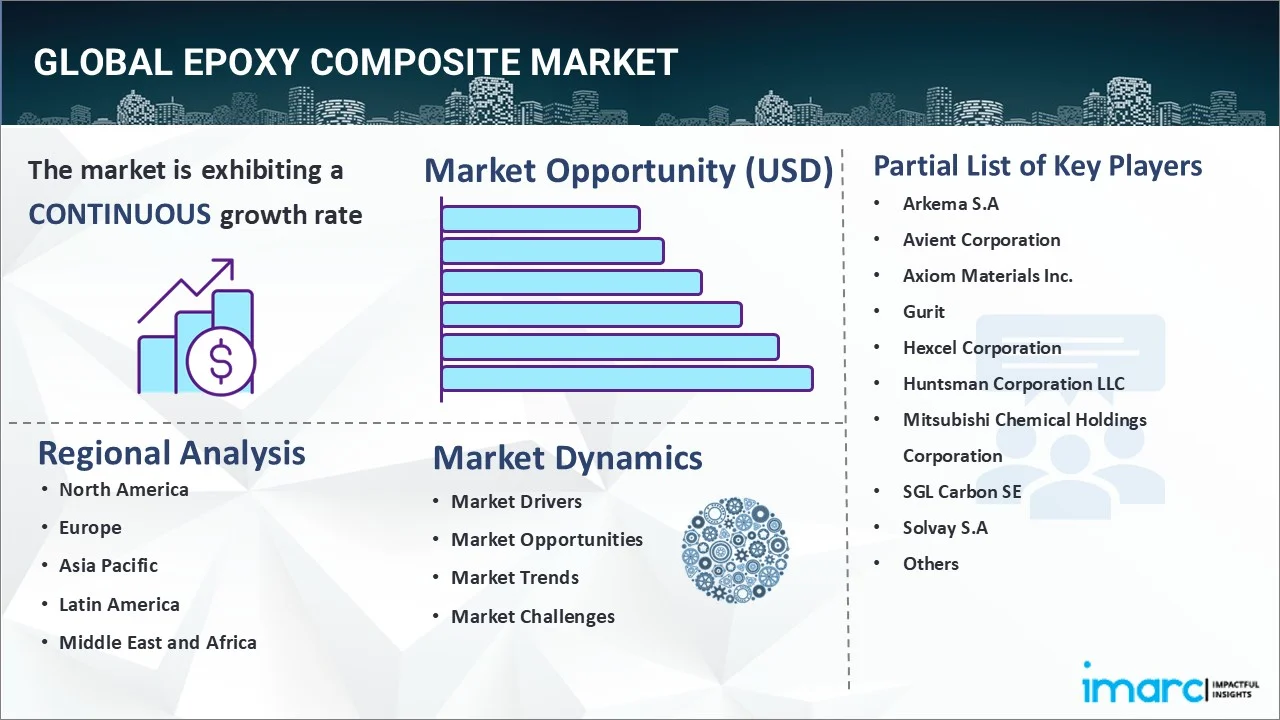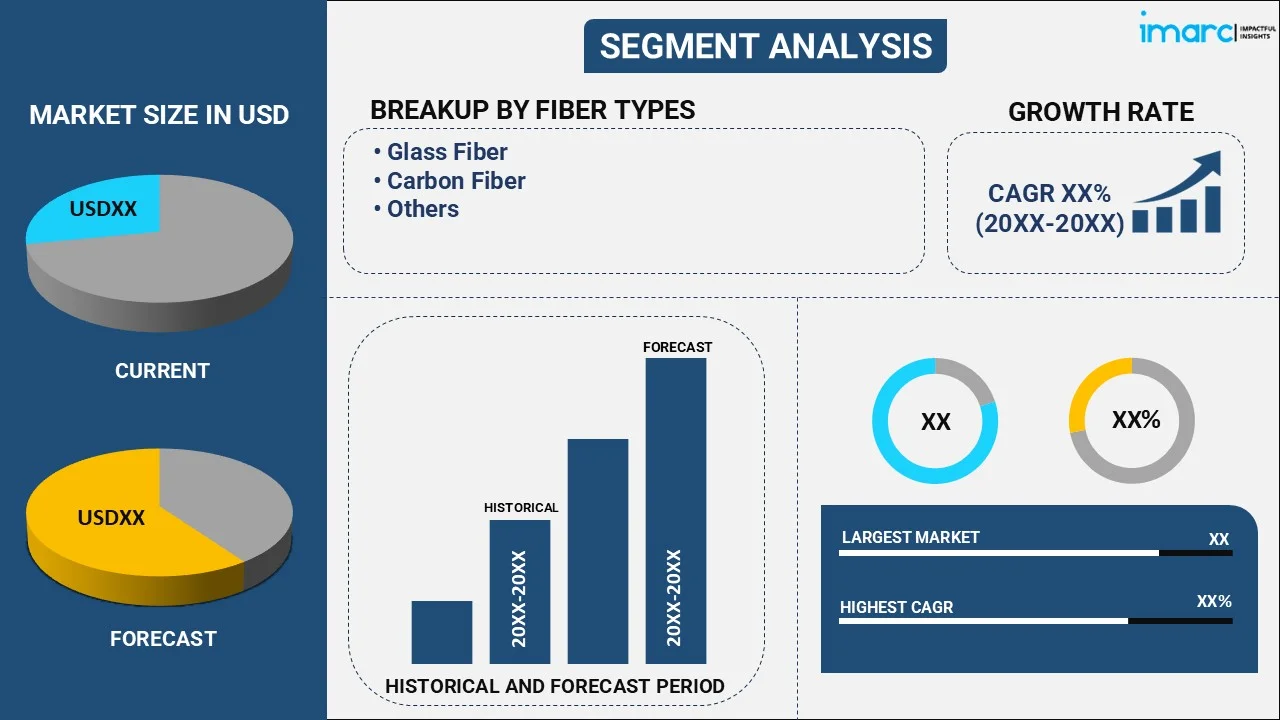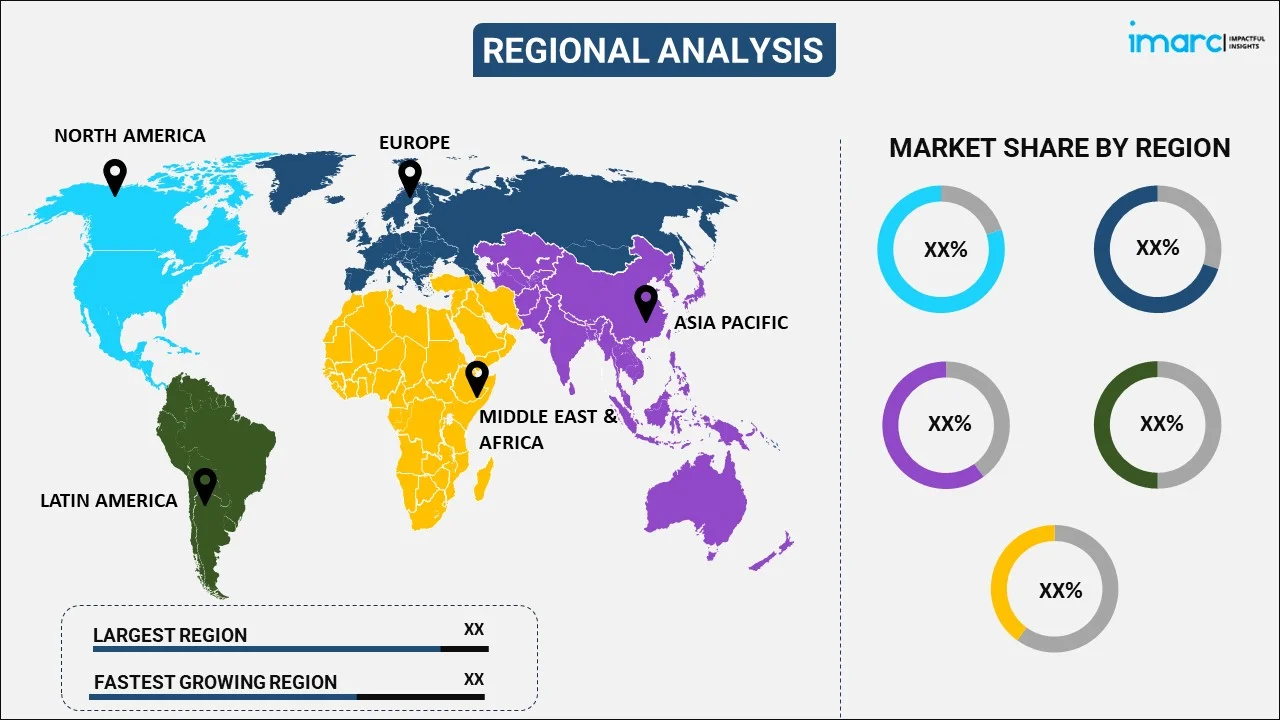
Epoxy Composite Market Report by Fiber Type (Glass Fiber, Carbon Fiber, and Others), Manufacturing Process (Lay-up, Compression Moulding, Resin Injection, Resin Transfer Moulding, Filament Winding, Pultrusion), End User (Aerospace and Defense, Automotive, Electrical and Electronics, Wind Energy, Sporting Goods, Marine, Piping, and Others), and Region 2025-2033
Market Overview:
The global epoxy composite market size reached USD 36.1 Billion in 2024. Looking forward, IMARC Group expects the market to reach USD 56.4 Billion by 2033, exhibiting a growth rate (CAGR) of 5.09% during 2025-2033.
|
Report Attribute
|
Key Statistics
|
|---|---|
|
Base Year
|
2024
|
|
Forecast Years
|
2025-2033
|
|
Historical Years
|
2019-2024
|
|
Market Size in 2024
|
USD 36.1 Billion |
|
Market Forecast in 2033
|
USD 56.4 Billion |
| Market Growth Rate 2025-2033 | 5.09% |
Epoxy composite is a type of material that employs epoxy resin for creating a polymer matrix, which is reinforced with fibers or other fillers to manufacture durable components with high strength-to-weight ratios. Some of the commonly used methods for producing epoxy composites include hand layup, compression, filament winding, and injection resin and resin molding processes. As compared to conventional construction materials, such as metal and concrete, epoxy composite is more lightweight, flexible, and cost-effective, and exhibits excellent adhesion and superior ultraviolet (UV) radiation, chemical, and heat resistance properties. This, in turn, protects the object from deterioration, due to which it is extensively used in various industrial applications. At present, epoxy composite is mainly available in glass and carbon fiber types.

Epoxy Composite Market Trends:
One of the key factors driving the epoxy composite market is the widespread product adoption in load-bearing applications, including automotive, aerospace, oil and gas, and construction industries, due to their improved mechanical properties, high adhesiveness, heat and solvent resistance, and low costs. Additionally, epoxy composites exhibit various beneficial properties, such as being lightweight, exhibiting resistance to fatigue, and offering lack of shrinkage after cooling, due to which they are frequently combined with carbon and glass fiber to manufacture wind blades. As a result, there has been a fueling demand for epoxy composites in the wind energy industry for producing and coating components, which is acting as another growth-inducing factor. In line with this, significant technological advancements and the introduction of several effective and affordable production solutions for manufacturing epoxy composites in bulk are contributing to the market growth. Other factors, such as strategic collaborations amongst key players and ongoing investments in the research and development (R&D) activities for producing versatile epoxy resin that can be deployed as a key component to construct air and watercraft, are creating a positive outlook for the market.
Key Market Segmentation:
IMARC Group provides an analysis of the key trends in each sub-segment of the global epoxy composite market report, along with forecasts at the global, regional and country level from 2025-2033. Our report has categorized the market based on fiber type, manufacturing process and end user.
Breakup by Fiber Type:

- Glass Fiber
- Carbon Fiber
- Others
Breakup by Manufacturing Process:
- Lay-up
- Compression Moulding
- Resin Injection
- Resin Transfer Moulding
- Filament Winding
- Pultrusion
Breakup by End User:
- Aerospace and Defense
- Automotive
- Electrical and Electronics
- Wind Energy
- Sporting Goods
- Marine
- Piping
- Others
Breakup by Region:

- North America
- United States
- Canada
- Asia-Pacific
- China
- Japan
- India
- South Korea
- Australia
- Indonesia
- Others
- Europe
- Germany
- France
- United Kingdom
- Italy
- Spain
- Russia
- Others
- Latin America
- Brazil
- Mexico
- Others
- Middle East and Africa
Competitive Landscape:
The competitive landscape of the industry has also been examined along with the profiles of the key players being Arkema S.A, Avient Corporation, Axiom Materials Inc., Gurit, Hexcel Corporation, Huntsman Corporation LLC, Mitsubishi Chemical Holdings Corporation, SGL Carbon SE, Solvay S.A, Teijin Limited and Toray Industries Inc.
Report Coverage:
| Report Features | Details |
|---|---|
| Base Year of the Analysis | 2024 |
| Historical Period | 2019-2024 |
| Forecast Period | 2025-2033 |
| Units | Billion USD |
| Segment Coverage | Fiber Type, Manufacturing Process, End User, Region |
| Region Covered | Asia Pacific, Europe, North America, Latin America, Middle East and Africa |
| Countries Covered | United States, Canada, Germany, France, United Kingdom, Italy, Spain, Russia, China, Japan, India, South Korea, Australia, Indonesia, Brazil, Mexico |
| Companies Covered | Arkema S.A, Avient Corporation, Axiom Materials Inc., Gurit, Hexcel Corporation, Huntsman Corporation LLC, Mitsubishi Chemical Holdings Corporation, SGL Carbon SE, Solvay S.A, Teijin Limited and Toray Industries Inc. |
| Customization Scope | 10% Free Customization |
| Post-Sale Analyst Support | 10-12 Weeks |
| Delivery Format | PDF and Excel through Email (We can also provide the editable version of the report in PPT/Word format on special request) |
Key Questions Answered in This Report
The global epoxy composite market was valued at USD 36.1 Billion in 2024.
We expect the global epoxy composite market to exhibit a CAGR of 5.09% during 2025-2033.
The rising demand for epoxy composite across several industries, such as automotive, aerospace, oil and gas, construction, etc., owing to its improved mechanical properties, high adhesiveness, heat and solvent resistance, low costs, etc., is primarily driving the global epoxy composite market.
The sudden outbreak of the COVID-19 pandemic had led to the implementation of stringent lockdown regulations across several nations, resulting in the temporary halt in numerous production activities for epoxy composite.
Based on the fiber type, the global epoxy composite market has been segregated into glass fiber, carbon fiber, and others. Among these, glass fiber currently holds the largest market share.
Based on the end user, the global epoxy composite market can be bifurcated into aerospace and defense, automotive, electrical and electronics, wind energy, sporting goods, marine, piping, and others. Currently, the automotive industry exhibits a clear dominance in the market.
On a regional level, the market has been classified into North America, Asia-Pacific, Europe, Latin America, and Middle East and Africa, where Asia-Pacific currently dominates the global market.
Some of the major players in the global epoxy composite market include Arkema S.A, Avient Corporation, Axiom Materials Inc., Gurit, Hexcel Corporation, Huntsman Corporation LLC, Mitsubishi Chemical Holdings Corporation, SGL Carbon SE, Solvay S.A, Teijin Limited, and Toray Industries Inc.
Need more help?
- Speak to our experienced analysts for insights on the current market scenarios.
- Include additional segments and countries to customize the report as per your requirement.
- Gain an unparalleled competitive advantage in your domain by understanding how to utilize the report and positively impacting your operations and revenue.
- For further assistance, please connect with our analysts.
 Inquire Before Buying
Inquire Before Buying
 Speak to an Analyst
Speak to an Analyst
 Request Brochure
Request Brochure
 Request Customization
Request Customization




.webp)




.webp)












